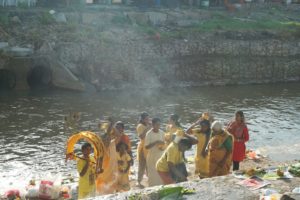
Thaipusam is a joyous, colorful, and loud Hindu festival, celebrated yearly in January. In Malaysia, it’s a national holiday. While some residents take advantage to make a long weekend trip out of town, the Tamil community comes together to celebrate Lord Murugan - who represents the struggle of good over evil. As MCG members, we were lucky to be able to experience this intense festival almost like insiders - thanks to photographer Cheryl Hoffmann. Our small group took the train to the Batu Caves stop, where Cheryl met us. We gathered early in the morning, to beat the heat and to also avoid the bigger crowds that would come later. Cheryl gave us a very thorough explanation of what Thaipusam is about, enabling us to observe with a decent understanding of what was going on.




We walked to the area beside the river, where devotees were preparing to make their ascent of the Batu Caves steps. Even at 8 am, the place was already crowded with families making their preparations. The morning light was wonderful for taking photos, and none of the festival devotees seemed to mind us doing so.
People were bathing in the river to purify themselves. There were tents set up, where men, women and children had their heads shaved. Via Cheryl, we also learned that people had fasted and practiced abstinence in the weeks before participating in the festival.
There were many little pujas (altars) set up on the ground, where priests were blessing pots of milk. Later, we would see devotees carrying these pots of milk on their heads, up the many steps to the temple at the top inside the caves.
We also saw men prepare to take the kavadi (burden). The kavadi is a colorful, round and heavy decorative frame the men wear on their back and shoulders. They are ornamented with many flowers and peacock feathers. We were actually able to watch these being bolted on to their wearers, as the men got ready. Many of the kavadi bearers also practice mortification of the flesh.
We were able get up close to see people having their tongues pierced with a golden spear (or vel), and to see people piercing their backs with hooks, which held small pots of milk. Somehow, no blood appears to be shed in the process. The prevailing atmosphere was one of joy.



After we’d seen our fill of the staging area, Cheryl guided us back across the river to the Batu Caves. We essentially followed one of the many groups of devotees as they walked and supported their kavadi bearer, with his heavy burden. Along the way, the kavadi bearer had to stop and sit down to rest on a stool, provided by his support group. It was a brutally hot day, and very hard to imagine how difficult this journey up the many steps of the Batu cave steps must be. We even observed some people making their way up the steps on their knees! Unbelievably, the kavadi bearers stopped to perform a whirling, joyous dance, accompanied by drummers, prior to ascending the steps.
While most of the group followed Cheryl up the steps to see what happens inside the caves, I was feeling too hot and overwhelmed to join. At the temples inside, the devotees offer up their pots of milk to Lord Murugan. I waited for the group at the bottom of the steps. After everyone returned, we all got a snack and some drinks at a nearby restaurant. Cheryl answered a few more questions, and then we all set off home.
I’m very grateful to MCG, and to Cheryl Hoffmann for the unique opportunity to experience this festival in a curated way. Cheryl has many years of knowledge and experience from photographing these festivals, and she is very generous to share her knowledge with us.
By Charlotte Sullivan

